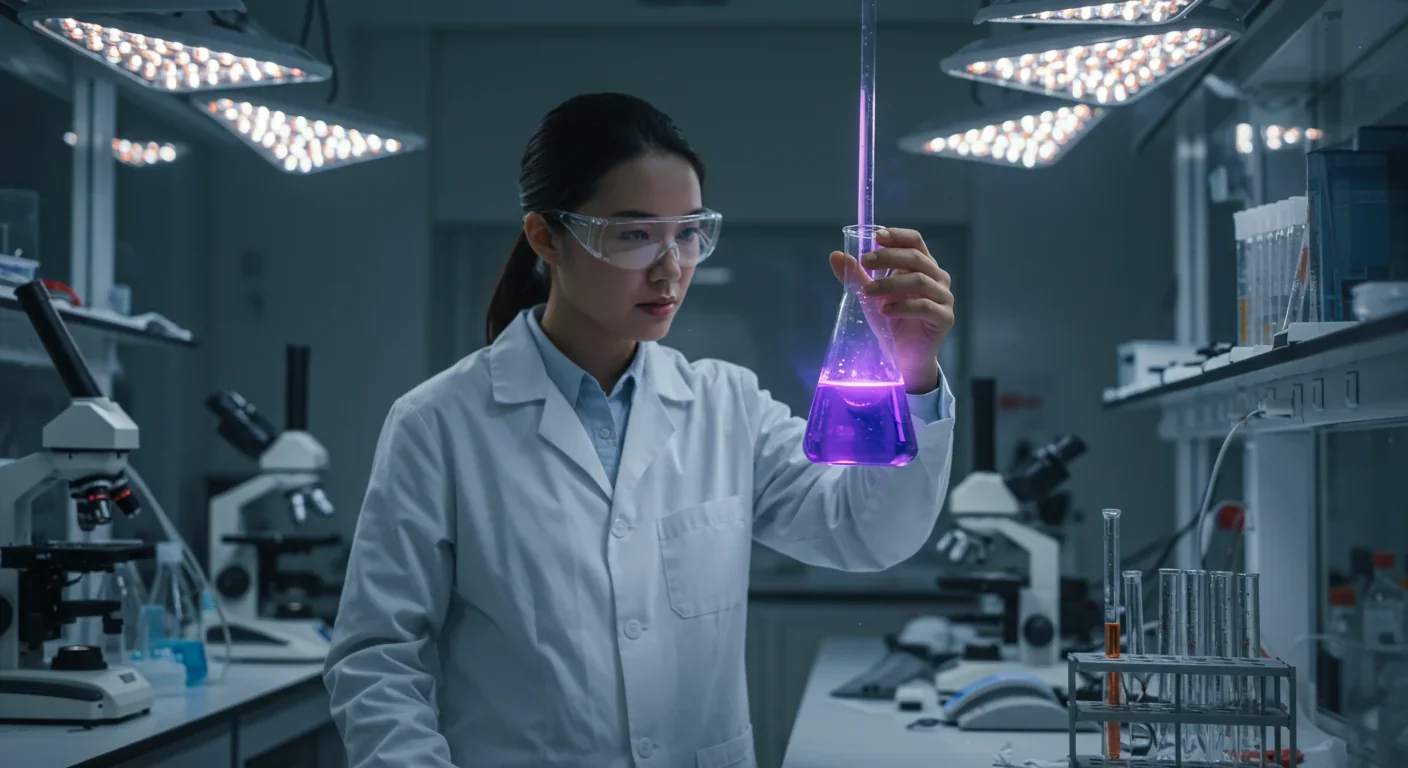Forest Biological Clocks: Ecosystems That Keep Time

TL;DR: Halophilic archaea thrive in salt concentrations that kill other organisms, using unique molecular strategies like pumping potassium chloride and light-driven proton pumps. Their extreme adaptations now inspire vaccines, bioremediation, and the search for extraterrestrial life.

Within the next decade, you'll likely encounter technology inspired by organisms that thrive where nothing else can survive. Deep in salt lakes so concentrated they'd mummify your cells in minutes, ancient microbes called halophilic archaea are not just surviving but thriving, and their secrets could reshape everything from vaccine delivery to the search for life on Mars.
Most cells placed in concentrated brine shrivel and die as water rushes out through osmosis. Yet halophilic archaea flourish in environments with salt concentrations reaching 20-30%, levels that would instantly desiccate human tissue. These microorganisms, discovered in salt lakes and salterns worldwide, represent one of nature's most counterintuitive survival strategies.
Recent research on Halobacterium salinarum strain AD88 from Mexico's Cuatro Cienegas Basin revealed something extraordinary: this was the first recorded diploid strain of Halobacterium, carrying only two genome copies instead of the 10-25 typical of other strains. This energy-saving adaptation suggests evolution fine-tuned these organisms for survival in the harshest conditions imaginable.
The discovery matters because halophilic archaea aren't just biological curiosities. They're living proof that life's boundaries extend far beyond what we once imagined possible.
The story of halophiles begins billions of years ago when Earth's oceans were far saltier than today. As continents shifted and seas evaporated, these archaea became specialists, evolving molecular machinery that works best in conditions lethal to almost everything else.
Scientists first noticed them in the 1800s when salted fish turned pink and spoiled. But nobody understood why until the mid-20th century, when researchers realized these weren't bacteria at all but archaea, an entirely separate domain of life more closely related to us than to bacteria.
That realization kicked off decades of research revealing just how different these organisms are. Their proteins carry an average isoelectric point of 5.03, making them highly acidic and able to remain stable in hypersaline conditions where normal proteins would aggregate and fail.
To understand halophilic archaea, you need to grasp their fundamental strategy: they don't resist salt, they embrace it.
While most organisms use organic compatible solutes to balance osmotic pressure, halophiles pump massive amounts of potassium chloride into their cells, matching the external sodium chloride concentration. This "salt-in" strategy requires every single protein to be redesigned with extra acidic amino acids on their surfaces, creating a hydration shell that keeps them functional.

Their cell membranes contain ether lipids instead of the ester lipids found in most life forms. These ether bonds make membranes more stable in extreme conditions, preventing them from breaking down.
Perhaps most remarkable is bacteriorhodopsin, a purple protein that acts as a light-driven proton pump. When oxygen runs low, halophilic archaea switch to this solar-powered system, generating ATP using sunlight without photosynthesis. It's a completely different way of harnessing solar energy, and it works brilliantly in high-salt environments where dissolved oxygen is scarce.
The unique biology of halophilic archaea is opening doors to applications that seemed like science fiction just years ago.
In vaccine development, researchers have engineered Halobacterium gas vesicles to display viral epitopes and act as natural adjuvants. These hollow protein structures float cells to oxygen-rich surface waters, but when genetically modified, they can deliver vaccine antigens while simultaneously boosting immune response. Early trials in mice showed robust antibody production, suggesting a new route for vaccines that don't require refrigeration, a game-changer for low-resource settings.
Bioremediation represents another frontier. Studies show halophilic microorganisms can break down petroleum hydrocarbons, remove toxic heavy metals, and even degrade microplastics in hypersaline wastewater. Oil spills in salt marshes and industrial brine waste, previously nearly impossible to clean, now have potential biological solutions.
The pharmaceutical industry is particularly interested in halophilic enzymes. These proteins function optimally in high-salt conditions, making them ideal for processes involving brines or preservatives. Lipases, proteases, amylases, and xylanases from halophiles are already being tested for food processing, detergent manufacturing, and drug synthesis.
The promise extends beyond practical applications to fundamental shifts in how we engineer biological systems.
Bacteriorhodopsin's robustness has made it a candidate for optoelectronic devices. Researchers have demonstrated optical switches operating at 1 kHz and holographic data storage systems using this protein. Unlike silicon-based electronics, these bioelectronic components could theoretically operate in extreme environments like deep-sea probes or even spacecraft.
Industrial fermentation processes often require maintaining sterile conditions, an expensive proposition. But halophilic archaea offer an elegant workaround: run the process in concentrated brine. Contaminants can't survive, so you get natural sterility without autoclaves or filters. This could dramatically reduce costs for producing enzymes, biofuels, and specialty chemicals.
The energy efficiency of these organisms also deserves attention. By using light-driven proton pumps and maintaining only two genome copies, strains like AD88 demonstrate how life can minimize metabolic overhead. As we design synthetic organisms for industrial purposes, these natural optimization strategies provide blueprints for efficiency.
Not everything about halophilic biotechnology is straightforward, though.
First, there's the scale-up problem. Most halophile research happens in small lab cultures. Industrial-scale production in hypersaline conditions presents engineering challenges nobody's fully solved. Corrosion of equipment, salt precipitation, and maintaining stable brine chemistry at thousands of liters create headaches for process engineers.
Environmental concerns exist too. Releasing genetically modified halophiles, even with safety genes, into natural hypersaline ecosystems could disrupt microbial communities we barely understand. The Dead Sea's microbial ecology, for instance, relies on complex necrophagic networks where archaea consume dead cells for survival. Introducing novel strains might collapse these delicate systems.
There's also the intellectual property minefield. As companies race to patent halophile-derived enzymes and processes, indigenous communities near salt flats and hypersaline lakes where these organisms were collected often see no benefit. The Atacama Desert in Chile and the Cuatro Cienegas Basin in Mexico harbor unique halophilic biodiversity, but biopiracy concerns are mounting as commercial interest grows.
And let's be honest about the hype cycle. Bacteriorhodopsin-based computing was supposed to revolutionize data storage in the 1990s, but here we are, still using silicon. Overpromising on halophilic technologies could lead to funding cuts and missed opportunities when the timeline turns out to be longer than press releases suggest.

Perhaps the most profound implication of halophilic archaea lies beyond our planet entirely.
Mars once had liquid water, but any that remains today is likely in underground brines with salt concentrations far exceeding Earth's oceans. Research shows that halophilic archaea's molecular adaptations could allow tolerance of perchlorate salts found in Martian regolith. If life exists or existed on Mars, it might look biochemically similar to Earth's halophiles.
Europa, Jupiter's ice-covered moon, almost certainly harbors a subsurface ocean. Evidence suggests this ocean is salty, possibly hypersaline in some regions. The discovery that halophiles can survive radiation thanks to bacterioruberin pigments and high potassium chloride concentrations makes them prime analogs for potential Europan life.
NASA and ESA researchers are using halophilic archaea as model organisms to understand biosignatures we might detect on other worlds. If we find life elsewhere in the solar system, recognizing it may depend on understanding extremophiles like halophiles first.
Scientific interest in halophilic archaea varies dramatically across the globe, shaped by local resources and priorities.
In China, researchers focus heavily on industrial applications. Teams at the Chinese Academy of Sciences have filed numerous patents for halophilic enzymes in food processing and textile manufacturing. The government views extremophile biotechnology as a strategic industry, pouring funding into applied research.
European scientists, particularly in Spain and Germany, concentrate on ecology and evolution. Salt flats in the Iberian Peninsula and Germany's Lüneburg region provide natural laboratories. European research tends toward understanding how these ecosystems function rather than immediate commercialization, though pharma collaborations are increasing.
Middle Eastern countries with extensive salt flats, like Iran and Jordan, are exploring halophiles for bioremediation of oil-contaminated brine and agricultural applications. Biofilm research in the region examines how halophiles colonize and stabilize hypersaline sediments, potentially enabling plant growth in marginal soils.
Latin American researchers, particularly in Chile and Mexico, emphasize conservation and intellectual property rights. They've watched northern pharmaceutical companies harvest extremophiles from places like the Atacama without local benefit, and they're now demanding benefit-sharing agreements and joint research programs.
Meanwhile, Japan's synthetic biology community views halophiles as chassis organisms for building entirely new metabolic pathways. By starting with an organism already optimized for harsh conditions, they reason, you can engineer more robust industrial strains.
So what does all this mean for you?
If you work in biotechnology, pharmaceuticals, or environmental science, halophilic archaea are moving from academic curiosity to practical tool. Learning the basics of extremophile biology will become increasingly valuable. Universities are starting to offer specialized courses in extremophile biotechnology; several online platforms now include modules.
For investors, the halophile industry is nascent but growing. Companies like Halotek and Perstorp are already commercializing halophilic enzymes. The market remains small, but early movers could see significant returns as applications scale up.
From a policy perspective, we need international frameworks for extremophile bioprospecting. The Nagoya Protocol addresses genetic resources, but enforcement around microorganisms remains weak. Governments and NGOs must work together to ensure communities hosting unique hypersaline environments benefit from discoveries made there.
And if you're simply scientifically curious, halophilic archaea offer a window into life's astonishing adaptability. They remind us that evolution finds solutions we'd never imagine, that the impossible is merely the not-yet-discovered.
The next time you drive past a salt flat or see pink salt flats in a nature documentary, remember: those aren't empty wastelands. They're thriving ecosystems running on alien biochemistry, and they might just hold keys to some of humanity's biggest challenges.
Because in the end, life that survives by doing everything backward, that thrives where death seems certain, teaches us the most important lesson of all: the rules we think are universal often aren't, and the boundaries we think are final are just waiting to be crossed.

MOND proposes gravity changes at low accelerations, explaining galaxy rotation without dark matter. While it predicts thousands of galaxies correctly, it struggles with clusters and cosmology, keeping the dark matter debate alive.

Ultrafine pollution particles smaller than 100 nanometers can bypass the blood-brain barrier through the olfactory nerve and bloodstream, depositing in brain tissue where they trigger neuroinflammation linked to dementia and neurological disorders, yet remain completely unregulated by current air quality standards.

CAES stores excess renewable energy by compressing air in underground caverns, then releases it through turbines during peak demand. New advanced adiabatic systems achieve 70%+ efficiency, making this decades-old technology suddenly competitive for long-duration grid storage.

Our brains are hardwired to see patterns in randomness, causing the gambler's fallacy—the mistaken belief that past random events influence future probabilities. This cognitive bias costs people millions in casinos, investments, and daily decisions.

Forests operate as synchronized living systems with molecular clocks that coordinate metabolism from individual cells to entire ecosystems, creating rhythmic patterns that affect global carbon cycles and climate feedback loops.

Generation Z is the first cohort to come of age amid a polycrisis - interconnected global failures spanning climate, economy, democracy, and health. This cascading reality is fundamentally reshaping how young people think, plan their lives, and organize for change.

Zero-trust security eliminates implicit network trust by requiring continuous verification of every access request. Organizations are rapidly adopting this architecture to address cloud computing, remote work, and sophisticated threats that rendered perimeter defenses obsolete.